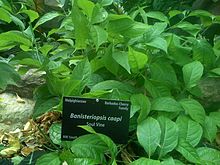Banisteriopsis caapi
| B. caapi | |
|---|---|
 |
|
| Young B. caapi | |
| Scientific classification | |
| Kingdom: | Plantae |
| (unranked): | Angiosperms |
| (unranked): | Eudicots |
| (unranked): | Rosids |
| Order: | Malpighiales |
| Family: | Malpighiaceae |
| Genus: | Banisteriopsis |
| Species: | B. caapi |
| Binomial name | |
|
Banisteriopsis caapi (Spruce ex Griseb.) C.V.Morton |
|
Banisteriopsis caapi, also known as ayahuasca, caapi or yagé, is a South American liana of the family Malpighiaceae. It is used to prepare ayahuasca, a decoction with a long history of entheogenic uses as a medicine and "plant teacher" among the indigenous peoples of the Amazon Rainforest. It contains harmine, harmaline, and tetrahydroharmine, all of which are both beta-carboline harmala alkaloids and MAOIs. The MAOIs in B. caapi allow the primary psychoactive compound, DMT (which is introduced from the other primary ingredient in ayahausca, the Psychotria viridis plant), to be orally active. The stems contain 0.11-0.83% beta-carbolines, with harmine and tetrahydroharmine as the major components. Alkaloids are present in all parts of the plant.
According to The CRC World Dictionary of Plant Names by Umberto Quattrocchi, the naming of B. caapi was actually dedicated to John Banister, a 17th-century English clergyman and naturalist. An earlier name for the genus Banisteriopsis was Banisteria, and the plant is sometimes referred to as Banisteria caapi in everyday usage.
The name ayahuasca means "vine of the soul" in Quechuan, and the shamans of the indigenous western Amazonian tribes use the plant in religious and healing ceremonies. In addition to its hypnotic effect, caapi is used for its healing properties as a purgative, effectively cleansing the body of parasites and helping the digestive tract.
...
Wikipedia
